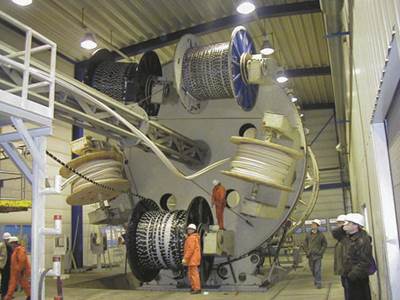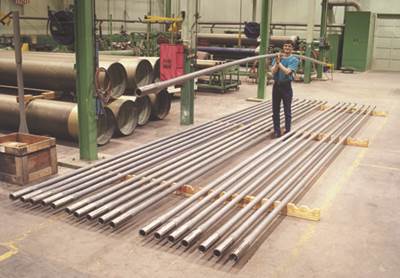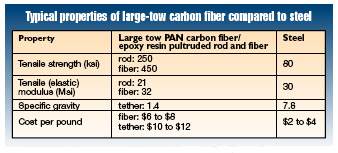Carbon Fibers
New-Generation Composite Buoyancy Elements Key For Deep Drilling And Production
Principal suppliers of riser buoyancy products include major producer Balmoral (Aberdeen, Scotland, U.K. and Houston, Texas, U.S.A.) and CRP Group Ltd. (Skelmersdale, Lancashire, England, U.K.), which also owns Emerson & Cuming (Canton, Mass., U.S.A.). Balmoral customizes epoxy resins, which are used to cr
Read MoreDesign Issues With Tendons
A composite tendon is essentially a rope made from small-diameter rods, which are pultruded with carbon fiber. Multiple rods are gathered together and twisted slightly to form a strand, using typical wire rope stranding methods. Depending on the performance requirements, 10 to 40 strands, about 2 to 3 inches/5
Read MoreComposite Drill Pipe An Available Option
Lincoln has been producing flexible composite drill pipe for short-radius, horizontal drilling since 1991. Its nominal 2.375 inch /60.3 mm (OD), 30 ft/9m long pipe shaft is filament wound with 12K carbon fiber combined with glass fibers in epoxy resin over an elastomeric liner. Standard API rotary shoulder too
Read MoreComposite Tether Goes To Sea
Conoco and KOP have manufactured a prototype of a carbon fiber composite tether that could extend TLP production to depths exceeding 10,000 ft/3,000 m. The design has undergone extensive static testing and fatigue loading and has been verified through hydrodynamic model testing. Sea testing is being planned.
Read MoreIssues With Design
Though steel is the traditional material for coiled tubing because of its low price, it is susceptible to corrosion, fatigue failure (caused by repeated coiling and uncoiling), and troublesome joints. In larger sizes, its weight can increase transport difficulties. With the advent of secondary recovery methods
Read MoreSpoolable Composite Tubular Applications
Applications for spoolable composite tubulars can be divided into three major areas — onshore, offshore and downhole. Onshore applications, which include production and gathering lines that convey fluids between wells and surface facilities, are well-suited to spoolable composite tubing and RTP. Offshore appli
Read MoreComposite Drilling Risers Many Years In The Making
The development of rigid composite riser systems has a history that spans two decades. Beginning in 1979, Aerospatiale and the Institut Français du Pétrole (IFP) developed a 15,000 psi, 4 inch composite tubular. Although this project started out as a feasibility study, by the mid-1980s it had led to the manufa
Read MoreCustom Wet Layup Repair Solutions
In the second group are customized repairs, employing glass or carbon reinforcement, wet out with vinyl ester, polyester or epoxy resin and applied to the pipe by trained personnel, have been available since the mid-1990s. Selection of reinforcement material, wrap thickness and overlay length is dictated by th
Read MoreCatenary Composite Risers
Catenary risers are able to absorb much more motion than top-tensioned risers, and, thus, are a common solution for wells tied back to an FPSO. Such a vessel experiences very high first-order motion in response to initial contact with wind or waves, making catenary risers a better solution than rigid component
Read More








.jpg;maxWidth=300;quality=90)


